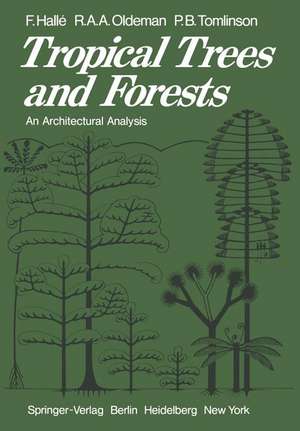Tropical Trees and Forests: An Architectural Analysis
Autor F. Halle, R. a. a. Oldeman, P.B. Tomlinsonen Limba Engleză Paperback – 15 dec 2011
Preț: 1121.23 lei
Preț vechi: 1367.35 lei
-18% Nou
Puncte Express: 1682
Preț estimativ în valută:
214.55€ • 224.46$ • 178.23£
214.55€ • 224.46$ • 178.23£
Carte tipărită la comandă
Livrare economică 03-17 aprilie
Preluare comenzi: 021 569.72.76
Specificații
ISBN-13: 9783642811920
ISBN-10: 3642811922
Pagini: 468
Ilustrații: XVIII, 444 p.
Dimensiuni: 170 x 244 x 25 mm
Greutate: 0.8 kg
Ediția:Softcover reprint of the original 1st ed. 1978
Editura: Springer Berlin, Heidelberg
Colecția Springer
Locul publicării:Berlin, Heidelberg, Germany
ISBN-10: 3642811922
Pagini: 468
Ilustrații: XVIII, 444 p.
Dimensiuni: 170 x 244 x 25 mm
Greutate: 0.8 kg
Ediția:Softcover reprint of the original 1st ed. 1978
Editura: Springer Berlin, Heidelberg
Colecția Springer
Locul publicării:Berlin, Heidelberg, Germany
Public țintă
ResearchCuprins
1 Introduction.- A. What is a Tree?.- I. Definitions.- II. Tree Making.- III. Apical Meristems and Tree Construction.- 1. Trees Built by One Meristem.- 2. Trees with Modular Construction.- 3. Trees with Trunk-Branch Differentiation.- 4. Trees with Changes in Orientation of Axes.- B. The Botanical World of the Tropics.- I. Distribution and Size of Flowering Plant Families.- II. Tropical Floras as Tree Floras.- III. Floristic Richness in Limited Areas.- IV. Geographic Locations.- V. Climate and Tree Growth in the Tropics.- 2 Elements of Tree Architecture.- A. The Initiation of the Tree.- I. Seedling Morphology.- II. Juvenility and Phases of Development.- B. Apical Meristems and Buds.- I. Terminal Buds.- II. Bud Composition.- III. Lateral Buds.- IV. Secondary Bud Complexes.- C. Extension Growth in Tropical Trees.- I. Introductory Remarks.- II. Rhythmic Growth.- 1. Rhythmic Growth in Hevea.- 2. Preformation and Neoformation.- 3. Further Examples of Rhythmic Growth.- III. Continuous Growth.- 1. Palms.- 2. A Dicotyledon.- D. Phyllotaxis and Shoot Symmetry.- I. Primary Orientation.- II. Secondary Orientation.- E. Branching: Dynamics.- I. Branch Order Terminology.- II. Syllepsis and Prolepsis.- 1. Definitions and Descriptions.- 2. Historical Usage of the Terms.- 3. Apical Dominance.- III. Continuous and Diffuse (Intermittent) Branching.- F. Branch Polymorphism: Long Shoots.- I. Orthotropy and Plagiotropy.- 1. Strict Orthotropy of Trunk Axes.- 2. Orthotropic Branches.- 3. Plagiotropic Branches (Reversible).- 4. Plagiotropic Branches (Nonreversible).- 5. Phyllomorphic Branches.- II. Branch Complexes and Sympodial Growth.- III. Plagiotropy and Syllepsis.- IV. Plagiotropy in Monocotyledons.- G. Branch Polymorphism: Short Shoots.- I. In Dicotyledons.- II. In Monocotyledons.- H. Abscission.- I. Inflorescence.- I. Flowering and Shoot Construction.- II. Continuous Flowering.- III. Cauliflory.- IV. Floral Phenology.- J. Radial Growth: Conifers and Dicotyledons.- I. Growth Rings.- II. Growth Rings in Tropical Trees.- III. Cambial Activity in Tropical Trees.- K. Radial Growth: Some Variations.- I. Trees Without Secondary Growth.- 1. The Palm-Habit.- 2. Bamboos.- 3. Tree Ferns.- II. Arborescent Monocotyledons with Secondary Growth.- III. Cycads.- L. Root Systems in Tropical Trees.- 3 Inherited Tree Architecture.- A. The Concept of Architecture and Architectural Tree Models.- I. The Architectural Continuum.- II. Recognition and Study of the Architectural Models.- III. Nomenclature.- IV. Recapitulation of Growth Criteria Used in Recognizing Models.- V. Size and Architectural Proportions — Corner’s Rules.- B. Illustrated Key to the Architectural Models of Tropical Trees.- C. Descriptions of Architectural Tree Models.- I. Illustrations of the Models — a Note of Explanation.- II. Monoaxial and Polyaxial Trees.- III. Plan of the Descriptive Arrangement.- IV. Monoaxial Trees.- Holttum’s Model.- Corner’s Model.- V. Polyaxial Trees.- 1. Vegetative Axes all Equivalent and Orthotropic.- Tomlinson’s Model.- Schoute’s Model.- Chamberlain’s Model.- McClure’s Model.- 2. Vegetative Axes Differentiated into Trunk and Branch.- Leeuwenberg’s Model.- Koriba’s Model.- PrÉvost’s Model.- Fagerlind’s Model.- Petit’s Model.- Nozeran’s Model.- Aubréville’s Model.- Massart’s Model.- Roux’s Model.- Cook’s Model.- Scarrone’s Model.- Stone’s Model.- Rauh’s Model.- Attims’ Model.- 3. Trees with Mixed Axes — an Introduction.- Mangenot’s Model.- Champagnat’s Model.- Troll’s Model.- D. Architecture of Lianes.- I. Lianes with an Architecture Conforming Closely to That of Tree Models.- II. Lianes with an Architecture Not Conforming to That of Known Tree Models.- E. Architecture of Herbs: Miniaturization in Relation to Tree Models.- 1. Miniaturization of Models.- 2. Origin of New Models.- F. Architecture of Fossil Trees.- 4 Opportunistic Tree Architecture.- A. Reiteration.- I. Reiteration as a Morphological Phenomenon.- II. The Organ Complexes Built by Reiteration.- 1. The Tree in the Forest.- 2. The Free-Standing Tree.- B. Energetics.- I. Trees in Their Environment.- 1. Energy Exchange.- 2. Energetic Efficiency.- 3. Energetic Economy in Whole Architecture.- 4. Spatial Disposition of Surface in Tree Crowns.- 5. Height-Diameter Relationship in Trees.- 6. Flexibility and Rigidity in Volume-Surface Integration.- II. Energy Exchange and Production.- III. Size and Architectural Proportions.- IV. Vigor and Death in Forest Trees.- V. Ecological Strategies of Trees.- C. Growth Potential of Forest Trees.- I. Trees of the Future.- II. Trees of the Present.- III. Trees of the Past.- IV. The Morphological Inversion Point.- V. Gymnosperms and Forests.- D. A Note on Floristics.- 5 Forests and Vegetation.- A. The Architecture of Forest Plots.- I. The Layered Forest.- II. The Architecture of Homeostatic Forest Plots.- 1. The Set of the Present.- 2. The Set of the Future.- 3. The Set of the Past.- 4. The Infrastructural Set: Meristems.- 5. Geometry of Homeostatic Forests with Their Vertical Gradients.- III. Examples of Forest Plots.- 1. A Forest at Montagne La Fumée, Saül, French Guiana.- 2. A Forest at Trois Sauts, Oyapock River, French Guiana.- 3. A Forest at Tom Swamp, Harvard Forest, Massachusetts.- IV. Morphological and Ecological Inversion Surfaces.- V. Variations in Homeostatic Architecture.- 1. Forest Imbrication on Slopes.- 2. Intertwining of Structural Ensembles.- 3. The Riverside Effect in Whole Canopies.- 4. Architecture of Forests with Strangling Figs 365 B. Sylvigenesis.- I. Disturbances of Existing, Functioning Forests.- II. The Chablis.- III. Homeostasis in the Forest.- IV. Sylvigenetic Cycles and Phases.- V. Tree Ecotopes.- VI. Biological Nomads and Towering Trees.- Concluding Remarks.- References.- Index of Plant Names and Their Models.












